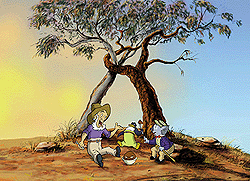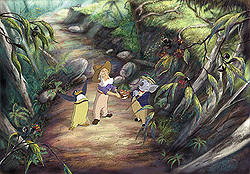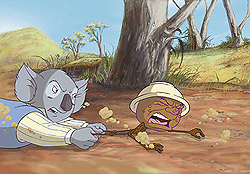Stephen Lynch interviews Robbert Smit, one of Australia's most experienced directors, on Energee Entertainment's latest feature and the trials and rewards of making a film in Oz.
Robbert Smit has been hailed as Australia's most experienced animation director. Not only has he worked on such television series as Scooby Doo, Dark Wing Duck and Two Stupid Dogs, but he has also directed the feature films Footrot Flats and Blinky Bill. As such, he is well-versed in the difficulties associated with adapting an Australian favourite into an animated feature film, a challenge he has risen to once more in his role as animation director of Energee Entertainment's production of The Magic Pudding. Recently I spoke to Robbert about this adaptation of Norman Lindsay's classic children's tale.

Stephen Lynch:
Unlike some animated features, you've actually tried to keep very close to the original design of the characters from the book. What sort of problems did that pose?
Robbert Smit:
That's a tricky one, because I actually wanted to make it even closer to the book drawings. More of a pencil sketch line, which in traditional animation you would achieve with cel artwork. However the requirement with this production was to push the boundaries and frontiers of digital application, so we had to modify the line work a little bit so that it could be more digital friendly. It's very difficult to do a sketch drawing and paint it on digital, because the colours go everywhere, so we had to work with a clean line to contain the colour areas of the character design. To compensate for the loss of that rough Lindsay line look, we added a lot of body contour shadow, drop shadow and highlights to the final image.
SL: That was particularly evident in the character of Bill Barnacle.
RS:
When characters are small you can get away with minimal body contour shadow. It's when you get up close to big characters and big body areas that you really need some additional moulding to break down the big flat areas, which on a cinematic screen can be very overwhelming.

SL:
How were the CGI shots on the film achieved?
RS: They were all done on the Inferno system. That was probably the most extreme hi-tech equipment that we used on the film.
SL: Did they pose problems with regard to budget?
RS:
Yes. We virtually had to go through the whole script, once we had the storyboard, and allocate areas where we could maximise the use of the 3D. Scenes, which with traditional animation would be very difficult to achieve, became quite achievable with the 3D format.
SL: Apart from the first appearance of the pudding where he drops through the clouds, what was the stand-out CGI shot for you?
RS: The one where he actually explodes. That was probably the biggest. It took 3 days to process, with each frame talking something like 1.4 minutes. It took some huge crunching. But all we did there was supply the artwork for six puddings and then we multiplied that over and over again. It was completely composited in Inferno using basic artwork and creating this massive explosion. To get that sort of quality and that amount of puddings would have been almost impossible to achieve in any traditional sense. There were great benefits of having that facility available.
SL:
How difficult was it creating new characters that were 'sympathetic' to the look of the original characters?
RS: Buncle went though quite a lot of changes. We came up with a human character first, which had some very good designs, but it just didn't quite gel. Then I thought Possum and Wombat, the innocent pudding thieves, were animal based and Buncle being the instigator of those two characters should have some kin relations. So then it became clear that Buncle should be an animal. I think we succeeded in making a villain, which looks like it could be a Norman Lindsay character. We derived a lot of the design work from Lindsay's other works, not just the book, but also his political cartoons of that time. We got a lot of inspiration for the other characters in the film from the other areas of work that he did.

SL:
The landscapes in the film have quite a unique look about them.
RS: I love the countryside of Australia. Coming from Holland, I'm very aware of the moods and colour changes, the light, and the shape of the mountains, and how they're different to Europe. Here they're rounded mountains, not sharp. It's an old continent, and the saturation of colour into the Australian light is so different than the European colour. The blues and the mauves that you see in the hills. Mauve is very much a basic theme colour all the way through the film. There's always a touch of mauve somewhere. It's that Blue Mountains-hazy backdrop. The difficulty was that Lindsay did not do too much color work. It was always black and white line work. So to get a sympathetic color scheme running through the film and still make it look like Lindsay was quite a challenge. As soon as you put colour to drawing it changes the whole feel.
SL: What are some of the challenges in making an animated feature film in Australia?
RS:
It's an ongoing difficulty. There are several factors. If you have an established studio like Disney, you have overlapping productions, so that animators can refine their art and continue to get better as they move along, because they have a constant flow of work, constant training schemes for new talent, constant handing down of information from older animators. Here we have this stop/start problem, where there is about six or seven years between productions. In that time you have huge changes. With the advent of digital animation, there's a big gap between the traditional animator and the new digital animator. That gap is actually creating a new breed of animator that hasn't got the traditional principles of animation, so you're constantly working with people who have knowledge, but of a different application. Therefore, it's difficult for us to get a good group together that can actually perform all the different aspects of animation as a cohesive form. And to get a group trained and working together, you need a lot of time, and we haven't got that time. So you have to appoint people to different positions of the film and hope that they can do the job to the best of their ability. That is a difficulty in this process.
SL:
Am I right in saying that digital animators don't have that training in form and movement?
RS:
It's more timing. Timing is the problem. Just discipline in the application of animation. The procedures of getting to an end result without having too many re-shoots. You can't blame the digital person because his area is so quick and easy to fix in comparison to the traditional animator, where everything has to be done right up front to get an end result.
SL: How much of the film was actually completed in Australia as opposed to off-shore work?

RS: All the pre-production was done here, as well as all the storyboarding, scripting, character design, layout, key animation scenes and character expressions. It was very imperative that we did that. However in this particular case we just could not get enough mature animators to animate up to feature film quality. So we had to go overseas for the bulk of the animation work. Then all the animation gets sent back here and we scan it and composite it all and do all the finishing art. We had to do it that way to get it done.
SL: Are you concerned about the competition the bigger studios may throw at the film when it's released?
RS: Well, I think dollar for dollar we are giving the audience a hell of a lot more than a 60 million dollar production. I can't see any other studio producing this kind of film, with the amount of work and quality that's in it, for a fifth of the price. I'm not saying that a fifth of the price is a good thing and that we should stick to that, but that's what we can manage to raise here and make something work. I think studios like Disney should take note that we made this for 10-12 million dollars, where they probably wouldn't touch this sort of project for less than 60 million dollars.
Stephen Lynch has written about the various aspects of filmmaking for books and magazines throughout Australia, England and America, as well as co-hosting Flicks, a weekly film review program.







